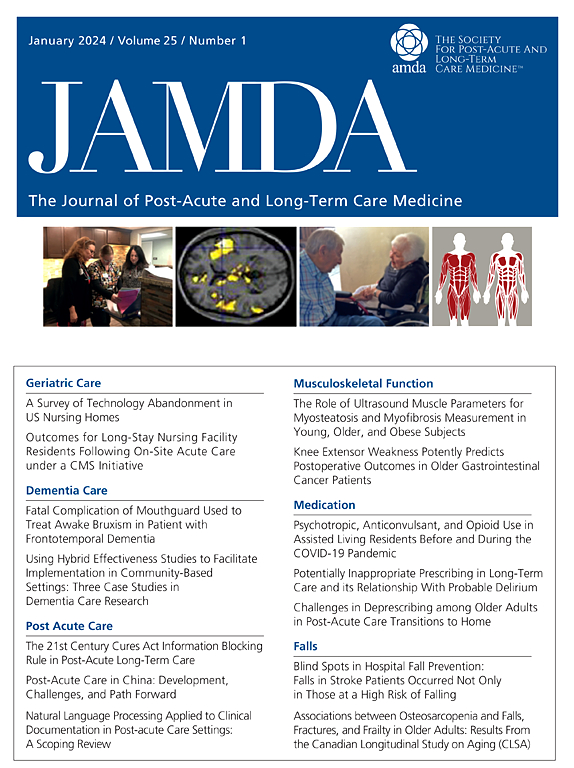慢性疼痛和不同类型的隔离对社区居住老年人残疾发生率的综合影响:前瞻性队列研究
IF 4.2
2区 医学
Q2 GERIATRICS & GERONTOLOGY
Journal of the American Medical Directors Association
Pub Date : 2025-07-17
DOI:10.1016/j.jamda.2025.105748
引用次数: 0
摘要
目标:社会孤立是一个重要的公共卫生问题,它会增加疼痛敏感性,加剧慢性疼痛,导致进一步的社会限制。然而,当这些因素重叠时,残疾的风险仍不清楚。本研究假设社会孤立和慢性疼痛共存会增加社区居住老年人的残疾发生率。设计:前瞻性队列研究。背景和参与者:本研究纳入4709名无基线残疾的社区居住老年人(73.8±5.4岁,男性:n = 2053)。方法:在基线时评估慢性疼痛、因缺乏社会支持而孤立和因缺乏社会参与而孤立。在24个月的随访期间检查残疾发生率。结果:在调整后的Cox比例风险模型中,由于缺乏社会支持而经历慢性疼痛和孤立的参与者的残疾发生率显著高于没有慢性疼痛或孤立的参与者(风险比[HR], 2.69;95% ci, 1.78-4.05;P < 0.001)。同样,经历过慢性疼痛和由于缺乏社会参与而被孤立的参与者,其残疾发生率显著高于没有慢性疼痛或被孤立的参与者(HR, 2.97;95% ci, 2.00-4.40;P < 0.001)。此外,慢性疼痛和缺乏社会参与导致的孤立在调整后具有加性效应(相互作用导致的相对超额风险,0.68;0.00 - -1.36)。结论和意义:慢性疼痛和缺乏社会参与导致的孤立感重叠在24个月内对残疾发生率有累加效应。这些发现强调了预防慢性疼痛和社会孤立的结合对于减轻残疾风险的重要性。本文章由计算机程序翻译,如有差异,请以英文原文为准。
The Combined Effects of Chronic Pain and Different Types of Isolation on the Incidence of Disability in Community-Dwelling Older Adults: Prospective Cohort Study
Objectives
Social isolation is a critical public health issue that increases pain sensitivity and exacerbates chronic pain, leading to further social limitations. However, the risk of disability when these factors overlap remains unclear. This study hypothesized that the coexistence of social isolation and chronic pain would elevate disability incidence among community-dwelling older adults.
Design
A prospective cohort study.
Settings and Participants
This study included 4709 community-dwelling older adults (73.8 ± 5.4 years of age, male: n = 2053) without baseline disability.
Methods
Chronic pain, isolation due to lack of social support, and isolation due to lack of social participation were assessed at baseline. Disability incidence was examined during a 24-month follow-up.
Results
In the adjusted Cox proportional hazards model, participants experiencing both chronic pain and isolation due to lack of social support provision had a significantly higher risk of disability incidence than those without chronic pain or isolation [hazard ratio (HR), 2.69; 95% CI, 1.78–4.05; P < .001]. Similarly, participants experiencing both chronic pain and isolation due to lack of social participation had a significantly higher risk of disability incidence than those without chronic pain or isolation (HR, 2.97; 95% CI, 2.00–4.40; P < .001). In addition, chronic pain and isolation due to lack of social participation had an additive effect after adjustment (relative excess risk due to interaction, 0.68; 95% CI, 0.00–1.36).
Conclusion and Implications
The overlap of chronic pain and isolation due to lack of social participation had an additive effect on disability incidence over 24 months. These findings highlight the importance of preventing the combination of chronic pain and social isolation to mitigate disability risk.
求助全文
通过发布文献求助,成功后即可免费获取论文全文。
去求助
来源期刊
CiteScore
11.10
自引率
6.60%
发文量
472
审稿时长
44 days
期刊介绍:
JAMDA, the official journal of AMDA - The Society for Post-Acute and Long-Term Care Medicine, is a leading peer-reviewed publication that offers practical information and research geared towards healthcare professionals in the post-acute and long-term care fields. It is also a valuable resource for policy-makers, organizational leaders, educators, and advocates.
The journal provides essential information for various healthcare professionals such as medical directors, attending physicians, nurses, consultant pharmacists, geriatric psychiatrists, nurse practitioners, physician assistants, physical and occupational therapists, social workers, and others involved in providing, overseeing, and promoting quality

 求助内容:
求助内容: 应助结果提醒方式:
应助结果提醒方式:


